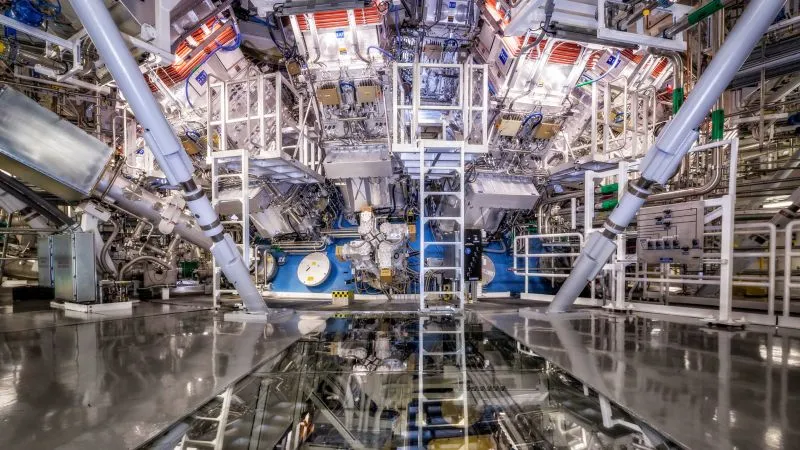It’s good to see some progress in this area. It’s something people have been working on for a very long time. I just wish they wouldn’t keep pitching it as a ‘solution to climate crisis’. It isn’t.
Fusion power is not currently viable. Progress is being made, but a lot more research is required before actual usable power plants can be designed; and then a lot more time will be required to actually build them. And even then, we’re only guessing about how good these power plants might be. They could be really great and clean, but currently they don’t exist at all. People have been working this this technology for a very long time, and it is yet to succeed. So the claims about problems it will solve are just hopeful speculation.
Climate change was once a distant future problem for which fusion power sounds like a good answer, but that was a long time ago now. Today, climate change is a right now problem and fusion power is still a distant future technology. We must not gamble the planet we all live on for a bet that fusion power is just around the corner and will somehow fix all our power needs. That would be a really bad bet to make. Delaying actual meaningful action in the hopes that future fusion will save the world… would be a mistake. So lets not think of fusion as a solution to climate change.
Fortunately we already have a fusion reactor available to us, we just have to get better at harnessing the energy it produces.
Indeed. And we are getting better at that. A lot better. Improvement in solar power have been happening a lot faster than fusion power. It’s far better than it use to be, and has the advantage that it is already very good today.
Yes, the goal should be improving solar, wind, and fission until fusion is ready, which might be two decades from now, or never, but advancing beyond fossil fuels should always be a combined effort in multiple fields. If nothing else, they’re frequently quite synergistic.
Today, climate change is a right now problem
Only for a significant majority of humanity. And species in general. You just gotta hustle and get that bunker built and you’ll be all good. Climate change is a hoax anyway, I saw a picture once of the ocean in the 50s, and a recent picture with no reference to tides, and the water levels were the roughly the same from about 500 metres away.
It is also about the philosophy of many people who are focused on fusion as the future. If we just had unlimited cheap power that would solve alllll of our problems…. which is a fundamental misunderstanding of what is really the crisis here.
I think the problem is that climate change isn’t a problem yet. Most people are merely inconvenienced by it. When it gets to be a real problem, it will be too late. That is why it is hard to rally people around the cause with more than words.
“Near limitless energy”. …
OK what are the limits? Preferably absurd answers please…
They boiled 10 kettles of water with this energy.
Ultimately, if everything is optimized, its probably only limited by the number of kettles available.
Limitless only for the same visit. 1 customer per reaction.
No repeat visits or sharing allowed!There is 1.4E21 kg of water on Earth. 0.03% of hydrogen is deuterium, a suitable fusion fuel. H2O has an atomic mass of 18 and O has an atomic mass of 16, so Earth has 4.7E16 kg of deuterium readily centrifuged out of ocean water.
D-D fusion converts about 0.1% of mass to energy (4 MeV / c^2 / 4 Daltons). E=mc^2. So we have 4.2E30 (420E28) Joules of fusion fuel ready for us on Earth. We used 2400 TWh of energy last year. If we used this amount indefinitely then we would have 485 billion years of fuel.
Bonus: deuterium depletion would have virtually no environmental effect.
This is the answer we all needed.
Since everyone else gave a joke answer I’ll take a stab in the dark and say the upper limits would be the availability of hydrogen and physical limitations in transforming heat output into electricity. The hydrogen is the most common element but 96% of it is currently produced from fossil fuels. After that, it would be how well you can scale up turbines to efficiently convert heat to electricity.
Electrolysis has up to 70% efficiency and needs sulfuric acid. The superheated thing has about 90% efficiency.
You know how the sun radiates an incredible amount of power through millions and millions of tonnes of material undergoing nuclear fusion every minute, and the sun is expected to last for millions of years?
Well, not that much. But it’s still a lot!
One limit less.
It’s near limitless in the sense that the fuel for it will not run out. … But to be honest, the ‘unlimited energy’ thing is mostly marketing hype. If we were worried about fuel running out, then solar would be the obvious go-to. That’s even less likely to run out than fusion power, and it has the advantage that we can already build it. And fusion, like solar and everything else, still requires land and resources to build the power plants. There are hopes that fusion power plants might be be more space efficient or something, but that obviously isn’t the case currently. Currently the situation is that people have been working on this for generations and the big breakthrough is that we can now momentarily break-even with power on a small scale with state of the art equipment. So I think it’s a bit too soon to claim it will have any advantages over solar. Right now it is not viable at all, and any future advantages are just speculation.
That said, fusion power is technology worth pursuing. It’s not complete garbage green-washing (unlike “carbon capture and storage”, which really is complete garbage), but the idea that fusion it’s some holy-grail of unlimited power is … well … basically just good marketing to keep the research funds flowing.
2 energies and no more
Only on Tuesdays between the times of 04:04 and 04:27 UTC
Ah, my childhood ISP is still luring around.
The flamingo population must remain constant for ignition to function.
“ Scientists in California shooting nearly 200 lasers at a cylinder holding a fuel capsule the size of a peppercorn have taken another step in the quest for fusion energy, which, if mastered, could provide the world with a near-limitless source of clean power. Last year on a December morning, scientists at the National Ignition Facility at the Lawrence Livermore National Laboratory in California (LLNL) managed, in a world first, to produce a nuclear fusion reaction that released more energy than it used, in a process called “ignition.” Now they say they have successfully replicated ignition at least three times this year, according to a December report from the LLNL. This marks another significant step in what could one day be an important solution to the global climate crisis, driven primarily by the burning of fossil fuels. For decades, scientists have attempted to harness fusion energy, essentially recreating the power of the sun on Earth.
After making their historic net energy gain last year, the next important step was to prove the process could be replicated.
Brian Appelbe, a research fellow from the Centre for Inertial Fusion Studies at Imperial College London, said the ability to replicate demonstrates the “robustness” of the process, showing it can be achieved even when conditions such as the laser or fuel pellet are varied.
Each experiment also offers an opportunity to study the physics of ignition in detail, Appelbe told CNN. “This provides valuable information to the scientists in addressing the next challenge to be overcome: how to maximize the energy that can be obtained.”
Unlike nuclear fission — the process used in the world’s nuclear plants today, which is generated by the division of atoms — nuclear fusion leaves no legacy of long-lived radioactive waste. As the climate crisis accelerates, and the urgency of ditching planet-heating fossil fuels increases, the prospect of an abundant source of safe, clean energy is tantalizing. Nuclear fusion, the reaction that powers the sun and other stars, involves smashing two or more atoms together to form a denser one, in a process that releases huge amounts of energy.
There are different ways of creating energy from fusion, but at NIF, scientists fire an array of nearly 200 lasers at a pellet of hydrogen fuel inside a diamond capsule the size of a peppercorn, itself inside a gold cylinder. The lasers heat up the cylinder’s outside, creating a series of very fast explosions, generating large amounts of energy collected as heat.
The energy produced in December 2022 was small — it took around 2 megajoules to power the reaction, which released a total of 3.15 megajoules, enough to boil around 10 kettles of water. But it was sufficient to make it a successful ignition and to prove that laser fusion could create energy.
Since then, the scientists have done it several more times. On July 30, the NIF laser delivered a little over 2 megajoules to the target, which resulted in 3.88 megajoules of energy — their highest yield achieved to date, according to the report. Two subsequent experiments in October also delivered net gains. “These results demonstrated NIF’s ability to consistently produce fusion energy at multi-megajoule levels,” the report said.
There is still a very long way to go, however, until nuclear fusion reaches the scale needed to power electric grids and heating systems. The focus now is on building on the progress made and figuring out how to dramatically scale up fusion projects and significantly bring down costs.
At the COP28 climate summit in Dubai, US climate envoy John Kerry launched an international engagement plan involving more than 30 countries with the aim of boosting nuclear fusion to help tackle the climate crisis.
“There is potential in fusion to revolutionize our world, and to change all of the options that are in front of us, and provide the world with abundant and clean energy without the harmful emissions of traditional energy sources,” Kerry told the climate gathering. In December, the US Department of Energy announced a $42 million investment in a program bringing together multiple institutions, including LLNL, to establish “hubs” focused on advancing fusion. “Harnessing fusion energy is one of the greatest scientific and technological challenges of the 21st Century,” said US Secretary of Energy Jennifer Granholm in a statement. “We now have the confidence that it’s not only possible, but probable, that fusion energy can be a reality.”
Ella Nilsen and René Marsh contributed to reporting
This is the best summary I could come up with:
Scientists in California shooting nearly 200 lasers at a cylinder holding a fuel capsule the size of a peppercorn have taken another step in the quest for fusion energy, which, if mastered, could provide the world with a near-limitless source of clean power.
This marks another significant step in what could one day be an important solution to the global climate crisis, driven primarily by the burning of fossil fuels.
Brian Appelbe, a research fellow from the Centre for Inertial Fusion Studies at Imperial College London, said the ability to replicate demonstrates the “robustness” of the process, showing it can be achieved even when conditions such as the laser or fuel pellet are varied.
As the climate crisis accelerates, and the urgency of ditching planet-heating fossil fuels increases, the prospect of an abundant source of safe, clean energy is tantalizing.
Nuclear fusion, the reaction that powers the sun and other stars, involves smashing two or more atoms together to form a denser one, in a process that releases huge amounts of energy.
In December, the US Department of Energy announced a $42 million investment in a program bringing together multiple institutions, including LLNL, to establish “hubs” focused on advancing fusion.
The original article contains 740 words, the summary contains 200 words. Saved 73%. I’m a bot and I’m open source!
I thought the Z machine at Sandia produced more than it consumed? That was like 20 years ago
I wonder what sort of problems having near-unlimited energy at our disposal would bring. Like, light and noise pollution are already bad enough. But would people be even more careless with that? And if we manage to automate most things and energy isn’t an issue, how would we live and occupy ourselves? How would that change industries and the world? How would that change things like war and power struggles in general? What about science and electronics?
It’s a bit concerning but also fascinating









